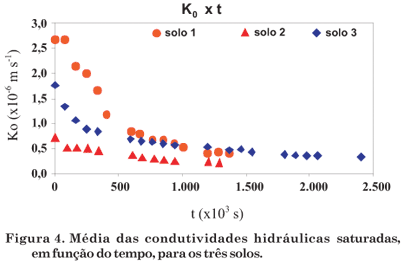Studies about solute movement in soil are frequently realized under laboratory conditions, in apparently controlled situations. A review of these studies showed that the variable time, to obtain the stationary condition, is frequently neglected. In view of this fact, the purpose of this study was to evaluate the time it takes until the water flow in saturated soil reaches the steady-state, by measuring saturated hydraulic conductivity (K0). The steady-state is the stage that precedes the application of the ion into soil samples in solute elution studies. Disturbed soil samples were collected in an experimental area of the ESALQ/USP. The soils had three different granulometries: very clayey, sandy-loam and sandy soil. PVC columns were filled with soil samples and then distilled and deaerated water was used for saturation and subsequent drainage in the columns, according to the experimental set-up of a constant-head permeameter. The data showed that for very clayey and sandy-loam samples, the steady-state was reached after 15 days and for the sandy soil after 27 days. The variability of K0 was higher in the first six test days. It was therefore concluded that the use of a fixed time for the addition of solutes in soil can result in a reduction of reliability in results.
hydraulic conductivity; steady-state; solute elution





